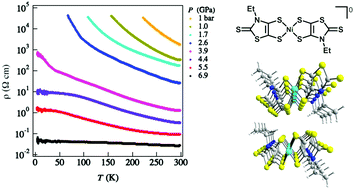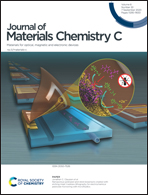Single-component conductors based on closed-shell Ni and Pt bis(dithiolene) complexes: metallization under high pressure†
Abstract
Neutral, closed-shell nickel and platinum bis(dithiolene) complexes are explored as single-component conductors. Four complexes formulated as [Ni(R-thiazdt)2]0 and [Pt(R-thiazdt)2]0 (R-thiazdt: 2-alkyl-1,3-thiazoline-2-thione-4,5-dithiolate; R = Me, Et) were obtained by electrocrystallization from the corresponding monoanionic species. Crystal and electronic structures confirm their semi-conducting behavior, and show the presence of a large HOMO–LUMO gap in the ethyl-substituted (R = Et) complexes while the less sterically hindered methyl-substituted ones exhibit higher conductivities and smaller activation energies. Application of high-quality quasi-hydrostatic pressures in the nickel series using a Diamond Anvil Cell (DAC) strongly enhances the conductivity of [Ni(Me-thiazdt)2]0, up to 166 S cm−1 (Eact = 0.1 meV) at 19 GPa. On the other hand, the N-ethyl derivative, [Ni(Et-thiazdt)2]0, turns metallic in the low temperature range (<100 K) when the pressure reaches 4.4 GPa, while a further increase of the pressure to 6.9 GPa turns it metallic over the whole temperature range. Pressure dependence of the activation energy for the methyl complex [Ni(Me-thiazdt)2]0 suggests that a pressure-induced structural transition hinders the metallization. On the other hand, first-principles calculations for high-pressure structures well explain the pressure-dependence of the conducting behavior of the ethyl complex [Ni(Et-thiazdt)2]0.



 Please wait while we load your content...
Please wait while we load your content...